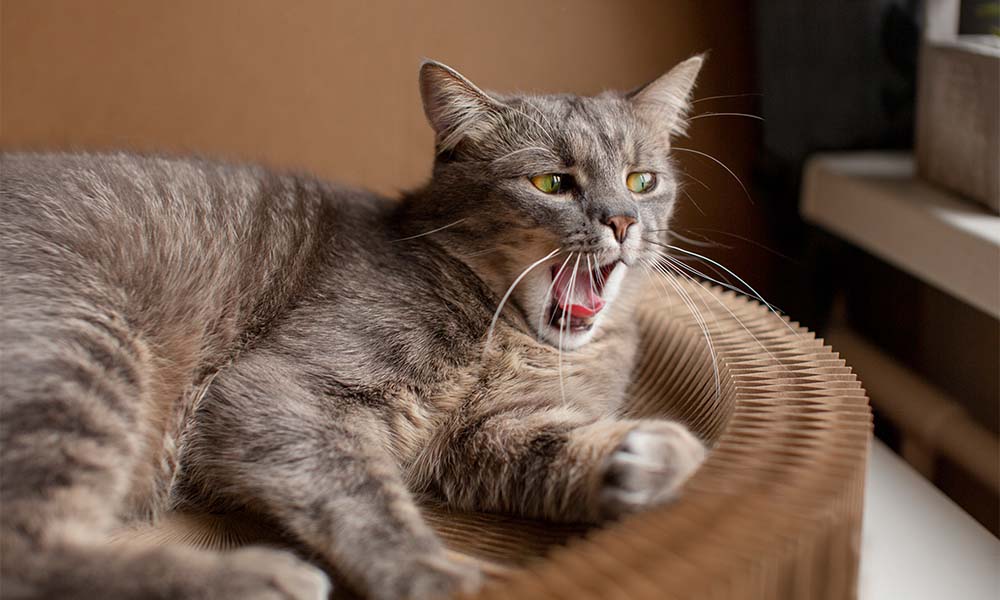Does your cat seem stressed? Do they constantly pace, hide, or overgroom? Their anxious behaviour can be a real heartbreaker, and you’re not alone. Cat anxiety is a common problem, and understanding the causes and tools for managing it can make a world of difference in your cat’s well-being.
Understanding Cat Anxiety
Cat anxiety is more common than many pet owners realise, and it can manifest in a variety of ways. Some cats may become more aggressive, while others might withdraw, hiding away from their usual social activities. Recognising these signs early is crucial in addressing the issue before it becomes more serious.
Behavioural Signs of Anxiety
- Hiding: Cats are naturally inclined to hide when they feel threatened, but chronic hiding can be a sign of underlying anxiety.
- Aggression: Sudden aggression towards people or other animals can indicate that your cat is stressed.
- Vocalisation: Excessive meowing, hissing, or growling can be a way for your cat to express their discomfort.
- Changes in Grooming Habits: Overgrooming or a complete lack of grooming can both be indicators of anxiety.
- Litter Box Issues: An anxious cat might stop using the litter box, which can often be misinterpreted as a behavioural problem rather than a stress response.
Common Causes of Cat Anxiety
Before we delve into the tools for helping your cat, let’s understand what’s causing their anxiety in the first place.
- Changes in Environment: Moving house, renovations, new furniture, or even a new family member can trigger anxiety in cats.
- Medical Conditions: Certain medical conditions, like hyperthyroidism or urinary tract infections, can manifest as anxious behaviour.
- Fear of Loud Noises: Fireworks, thunder, or even the vacuum cleaner can send some cats into a frenzy.
- Separation Anxiety: Some cats become anxious when left alone, especially if they haven’t been properly socialised.
- Lack of Enrichment: A bored cat is more likely to experience anxiety, so providing mental and physical stimulation is crucial.
Understanding these triggers is the first step in helping your cat feel more secure. By identifying what is causing your cat’s anxiety, you can tailor the solutions to address their specific needs.
The Importance of Identifying the Cause
Identifying the root cause of your cat’s anxiety is essential for addressing it effectively. If you suspect a medical issue, a visit to the vet is a must. Your vet can rule out or treat any underlying health problems, ensuring that your cat’s anxiety isn’t related to pain or discomfort.
Once you’ve ruled out any medical causes, you can focus on environmental and behavioural solutions. Understanding whether the anxiety is triggered by specific events, environments, or even other pets can help you make targeted changes that will have the most significant impact on your cat’s well-being.
Tools for Taming Cat Anxiety
Now, let’s get to the good stuff—the tools to help your feline friend relax and feel more secure.
1. Calming Pheromones
These synthetic pheromones replicate the natural calming scents cats use to communicate with each other. You can find them in diffusers, sprays, or collars.
- Feliway: This synthetic pheromone mimics the “happy” pheromone cats release when they’re feeling content and relaxed. Available in diffusers or sprays, Feliway can help create a calming environment in your home. It’s particularly useful during times of change, such as moving house or introducing a new pet.
- Comfort Zone: This pheromone spray is ideal for creating a calming atmosphere in specific areas, like a cat’s bed or a scratching post. Comfort Zone also offers a diffuser that can be plugged into the wall, continuously releasing pheromones to help reduce your cat’s stress levels.
These products are especially effective in multi-cat households or in environments where your cat may feel territorial stress. The pheromones help to create a sense of familiarity and security, reducing the likelihood of anxiety-driven behaviours.
2. Environmental Enrichment
A stimulating environment can help reduce anxiety by keeping your cat entertained and engaged. Providing your cat with a variety of activities can prevent boredom, which is a common cause of stress.
- Interactive Toys: Consider puzzle feeders, feather wands, or even laser pointers to keep them mentally stimulated. These toys encourage your cat to think and move, which can help alleviate anxiety.
- Vertical Space: Cats love to climb! Cat trees, shelves, or scratching posts provide them with a sense of security and vantage points to observe their surroundings. High perches allow your cat to feel safe and in control, which is particularly important in multi-cat households or busy environments.
- Hiding Places: Provide cosy hiding spots like cardboard boxes, tunnels, or covered beds for your cat to retreat to when they need some quiet time. These safe spaces give your cat somewhere to go when they feel overwhelmed, helping them to self-soothe.
Environmental enrichment is not just about physical activity; it’s also about providing mental stimulation. Puzzle feeders, for example, challenge your cat to work for their food, engaging their natural hunting instincts and providing a rewarding experience.
3. Behaviour Modification Techniques
Behaviour modification can be a highly effective way to reduce anxiety in cats. These techniques focus on changing how your cat reacts to anxiety triggers.
- Desensitisation and Counter-Conditioning: This involves gradually exposing your cat to the trigger of their anxiety while pairing it with something positive, like a treat or a favourite toy. Over time, your cat will start to associate the previously scary situation with something good, reducing their anxiety.
- Classical Conditioning: This technique involves associating a specific behaviour with a positive experience. For instance, you can create a positive association with the sound of a vacuum cleaner by using treats and playtime when the vacuum is on. Gradually, your cat will begin to see the vacuum as less of a threat and more of a signal for something enjoyable.
- Clicker Training: Clicker training can be a fun way to teach your cat new behaviours and redirect their attention away from anxious triggers. By using a clicker to mark desirable behaviour and following it with a reward, you can help your cat develop positive associations with new experiences.
These techniques require patience and consistency, but they can be incredibly effective in changing your cat’s emotional responses to stressors.
4. Soothing Music and Sounds
Did you know that music can also have a calming effect on cats? Just like with humans, certain types of music can help reduce stress in cats.
- Classical Music: Many cats find the soft, calming melodies of classical music relaxing. Studies have shown that classical music, with its slow tempos and gentle harmonies, can help lower stress levels in animals.
- Nature Sounds: Sounds of birds chirping, gentle rain, or waves crashing can help create a peaceful atmosphere. You can find playlists designed specifically for cats, which incorporate sounds that are known to be soothing to them.
Playing soothing music or nature sounds during stressful times—like thunderstorms or fireworks—can help drown out the noise and provide a calming background for your cat.
5. Nutritional Supplements
In addition to environmental changes and behavioural techniques, nutritional supplements can play a role in managing your cat’s anxiety. These supplements are designed to support your cat’s natural ability to cope with stress.
- L-theanine: This amino acid found in green tea has calming effects on both humans and cats. It works by increasing the levels of calming neurotransmitters in the brain, which can help reduce anxiety.
- Tryptophan: This essential amino acid helps produce serotonin, a neurotransmitter that promotes feelings of well-being. By increasing serotonin levels, tryptophan can help your cat feel more relaxed.
- Chamomile: Chamomile is known for its soothing properties and can be given to cats in small amounts. It can help calm an anxious cat and is often used in combination with other calming herbs.
Before introducing any supplements into your cat’s diet, it’s important to consult with your vet to ensure they’re appropriate for your cat’s specific needs.
6. Professional Support
If your cat’s anxiety is severe or you’re struggling to manage it, don’t hesitate to seek help from a certified veterinary behaviourist. They can provide personalised advice and a tailored treatment plan for your cat’s specific needs.
A veterinary behaviourist can offer a more in-depth analysis of your cat’s behaviour, identifying triggers that you may not have noticed. They can also prescribe anti-anxiety medications, if necessary, which can be used in conjunction with other tools and techniques to help manage your cat’s anxiety.
Creating a Calm Sanctuary
Creating a calm sanctuary for your cat involves building a sense of safety and security. This doesn’t happen overnight, but by incorporating these tools and making gradual changes, you can create an environment where your cat feels relaxed and at ease.
Creating the Perfect Space
- Designate a Quiet Area: Choose a room or corner of your home where your cat can retreat when they need to escape from noise or activity. This space should be equipped with their favourite bed, toys, and perhaps a diffuser with calming pheromones.
- Ensure Accessibility: Make sure your cat’s sanctuary is easily accessible. If your cat has mobility issues, ensure that they can easily get to their safe space without having to jump or climb.
- Consistency is Key: Cats thrive on routine. Keep their sanctuary consistent and avoid making frequent changes to their environment, which can trigger anxiety.
Remember: Patience is key! It may take time for your cat to adjust to new routines, tools, or environments. Be consistent with your efforts, and you’ll see progress over time.
Final Thoughts
A stressed cat is a far cry from the purring, playful feline you love. By understanding the common causes of cat anxiety and exploring the various tools available, you can work towards creating a calmer and happier home for your furry friend.
Managing cat anxiety is not just about treating the symptoms; it’s about understanding your cat’s needs and responding to them in a way that promotes their overall well-being. Whether through environmental changes, behavioural techniques, or professional help, there are many ways to help your cat live a more relaxed and fulfilling life.
Ready to Help Your Cat Feel at Home?
Ready to Help Your Cat Feel at Home? At Cat Castle, we specialise in creating enriching environments that cater to your cat’s unique needs. Our facility offers a stress-free, quiet stay with no dog boarding, ensuring a peaceful environment where your cat can truly relax. Cats naturally live in the moment, so whether you’re away for a few days or several weeks, they won’t feel abandoned—just like they’re on a little holiday of their own!
Visit us today, and let’s help your cat find their purr-fect calm.
Frequently Asked Questions
Signs of cat anxiety can include hiding, pacing, overgrooming, excessive vocalisation, aggression, changes in appetite, and altered litter box habits. If your cat is exhibiting any of these behaviours, it may be experiencing anxiety.
Always consult with your vet before using human products on your cat. Some human products can be toxic to cats, so it’s important to get professional advice to ensure your cat’s safety.
The time it takes for your cat to improve will depend on the severity of their anxiety, the underlying cause, and how well you can implement the strategies. Progress may be gradual, so patience and consistency are key.
If you’ve tried various methods and haven’t seen improvement, it’s important to consult with a veterinary behaviourist. They can help diagnose any underlying medical conditions or provide more specialised treatment plans tailored to your cat’s needs.





